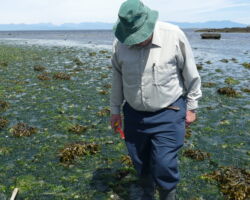Microscopic Shellfish and Gastropods of Coastal BC: how the study works
Microscopic Clams and Snails
Bill Merilees has been studying interesting clams and snails for almost 20 years. He is achieving remarkable results using relatively simple scientific tools and procedures.
He notes that all the shell reference books contain pictures of the big and showy species that are easily spotted on the beach. Not surprisingly there are many more tiny species there that are so small that they escape our casual gaze.
These are the focus of his study. It’s a project that he has taken on for himself – a great example of effective citizen science. His goal is to document all the species present on our coastal beaches. Turning up species new to our province or even to science has been a regular occurrence.
The Procedure
Bill selects a sampling site at the day’s location from somewhere from the Strait of Juan de Fuca to Haida Gwaii. Visiting new (for him) destinations is a magnet draw. He likes to arrive at the site just before low. Rocky beaches are preferred. He looks for a suitable site to sample (which in this case is on or under a rock).
His tools are very ‘low tech’ – a plastic bucket, zip-loc bag, pencil, field note book and a plain metal soup spoon. A pocket digital camera is a recent addition to the tool kit.
He uses the spoon to scrap an area about the size of a dinner plate down to bare rock. The scrapings are transferred into a zip-loc bag. He records data about the site into his field note book. The sampling does not take very long, just a few minutes.
Rocky beach areas are usually very slippery, so care is always required while moving. He carries a long-handled “gentleman’s shovel” as a walking aid for balance.
Recording Data
Bill uses a small bound notebook in the field to record the vital information on the site location and sample acquisition process. He records the date, the location, the sample number, height of the tide, and other observations such as the estimated size of the sample area. The data in the notebook is later very carefully transcribed into a permanent record in his computer at home.
The zip-loc sample bag is carefully numbered so that the sample will not be confused with any others once back at home.
Processing the Sample
1. Bill has a sink in his garage which is a convenient location for processing. This is usually at home but anywhere that there is running water works for him. He places the sample in a wash basin really rinses the ‘gunk’ with freshwater and shakes it well to separate the unwanted light debris from the other heavier material that sinks to the bottom.
2. The sample is sieved under flowing water through two home made sieves. One is a 5mm screen and the other is a 1mm screen.
3. It is the 1 – 5mm screened material that interests him – but when I took the leftovers (<1mm in size) I was amazed to see a myriad of small marine organisms in the sample. It could have kept me going for a couple of days - particularly if I had saved individual specimens for identification.
4. Bill then takes his sample and spreads it, one teaspoon full at a time, on a plate that he has ruled into strips (a rudimentary grid). The parallel lines equal the field of vision of his dissecting 10x microscope. This allows him to systematically scan the whole sample without missing anything. He moves the plate to bring new material into the field of view. This ensures that he will not accidentally count specimens more than once. He removes all clams and snails one at a time with very fine tweezers (forceps). He drops them into a small container of alcohol.
5. The picked material is later segregated by species identification and an accurate count made for the record. Once preserved, the sample is dried, sorted by species, counted and recorded.
Storing the Specimens
Interesting and unusual or new specimens are set aside with the remainder of the sample saved for future reference. Bill uses glass vials – each one carefully labelled and stuffed with cotton batting for long term storage. Nothing is thrown away
Some specimens of interest are carefully glued on small cards to be photographed and are held in a separate collection. These might be examples of new species that he has found – or ones suspected as being new to science.
Another skill set Bill possesses is woodworking – he built all his own storage cabinets and designed special holders in the drawers to hold the specimen tubes in place.
A mentor of Bill’s, Dr. Ian McTaggert-Cowan always told him “A project is not finished until the paper work is completed.” To him this meant the results were published or distributed.
The long-term goal of this labour of love is to record and document all the inter-tidal clam and snail species for British Columbia in a photographic reference work. He is working closely with a colleague, Rick Harbo, which he appreciates very much.
Bill reflects on his project saying “The shapes, colours and diversity of British Columbia’s inter-tidal micro-clams and snail fauna is something to celebrate. I do that by sharing it all with others! These mini-molluscs are at the base of the oceanic food chain.”




















